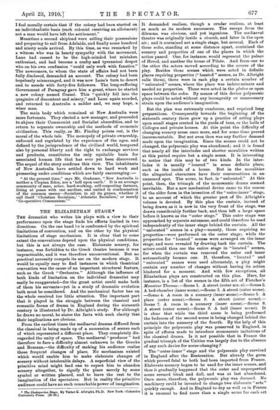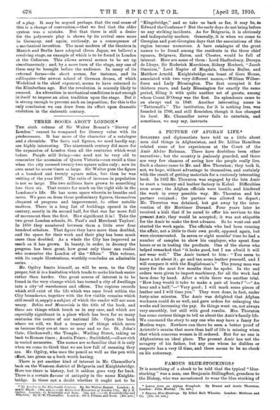THE ELIZABETHAN STAGE.*
THE dramatist who writes his plays with a view to their performance upon the stage finds his efforts limited in two directions. On the one hand 1.e is confronted by the spiritual limitations of convention, and on the other by the physical limitations of stage mechanism. It is clear that to some extent the conventions depend upon the physical conditions, but this is not always the case. Elaborate scenery, for instance, was forbidden to the Greek theatre because it was impracticable, and it was therefore unconventional. But no practical necessity compels its use on the modern stage. It would be equally easy to find instances in which theatrical convention was the cause of an important structural feature, such as the Greek " Orchestra." Although the influence of both kinds of limitation on the individual dramatist may easily be exaggerated—for the great artist could make both of them his servants—yet in a study of dramatic evolution both must be considered. And the mechanical factor has on the whole received too little attention. The important part that it played in the struggle between the classical and romantic forms of drama in England during the sixteenth century is illustrated by Dr. Albright's study. For although he draws no moral, he states the facts with such clarity that their implications are obvious.
From the earliest times the mediaeval dramas differed from the classical in being made up of a succession of scenes each of which represented a different place. They completely dis- regarded the unity of space. The mediaeval " producer " had therefore to face a difficulty almost unknown to the Greeks and Romans,—the difficulty of making his audience realise these frequent changes of place. No mechanism existed which would enable him to make elaborate changes of scenery without intolerable delays. A superficial view of the primitive mind might lead one to expect him to abandon scenery altogether, to signify the place merely by some symbol or written placard, and to leave the rest to the imagination of the spectators. But in reality the primitive audience could have no such remarkable power of imagination.
• The Shaksperiaa Stage. By Victor E. Albright, Ph.D. New York : Columbia University Press. [41'50.] It demanded realism, though a cruder realism, at least as much as its modern successors. The escape from the dilemma was obvious, and yet ingenious. The mediaeval theatre was originally inside a church, and later in the open air ; and it contained not a single stage, but several. Each of these sedes, standing at some distance apart, contained the scenery and properties of one of the places in which the action passed. One, for instance, would represent the palace of Herod, and another the house of Pilate. And from one to the other the actors moved according to the course of the play. Besides these scenes which were acted in definite places requiring properties (" located " scenes, as Dr. Albright calls them), there were in each play a certain number of "unlocated" scenes, where the place was indeterminate and needed no properties. These were acted in the platea or open space between the sedes. By means of this device polyscenic plays could be acted without any incongruity or unnecessary strain upon the audience's imagination.
But the plan was extremely cumbrous, and required long preparations. Consequently towards the beginning of the sixteenth century there grew up a practice of acting plays upon small stages erected in the yards of inns, or the halls of Colleges and private houses. At this point the difficulty of changing scenery arose once more, and for some time proved insurmountable. But not even then was any further demand made upon the imagination. Since the scenes could not be changed, the polyscenic play was abandoned; and it is found that nearly all the interludes and shorter moralities written at this period require but a single scene. It is interesting to notice that this may be of two kinds. In the inter- ludes it is usually " located " in some definite place, such as the inside of a house. But in the moralities the allegorical characters have their conversations in an unnamed spot. The scene, in fact, is "unlocated." At this point, then, the triumph of the monoscenic drama seemed inevitable. But a new mechanical device came to the rescue of the older form in the invention of the " outer-inner " stage, to an account of which the greater part of Dr. Albright's volume is devoted. By this plan the curtain, instead of being drawn as it is now in the very front of the stage, was drawn considerably further back, and thus left a large space before it known as the "outer stage." This outer stage was approached by separate entrances, and could therefore be used independently of the inner stage behind the curtain. All the " unlocated " scenes in a play—namely, those requiring no properties—were performed on the outer stage; while the properties for " located " scenes were arranged on the inner stage, and were revealed by drawing back the curtain. The actors could thus use the entire stage in "located" scenes, for when the curtain was removed the outer and inner automatically became one. If, therefore, " located " and " unlocated " scenes were used alternately, a play might contain any number of changes without having its action hindered for a moment. And with few exceptions, all Elizabethan plays are constructed on this plan. Here, for instance, is a list of the scenes in the fifth act of Fletcher's Monsieur Thomas :—Scene 1. A street (outer see :e).—Scene 2. A bed-chamber (inner scene).—Scene 3. A street (outer scene). —Scene 4. A room in a nunnery (inner scene).—Scene 5. A place (outer scene).—Scene 6. A. street (outer scene).— Scene 7. A room in a nunnery (inner scene).—Scene 8. A street (outer scene).—Scene 9. A hall (inner scene). It is clear that while the third scene is being performed the bedroom of the second scene is being changed behind the curtain into the nunnery of the fourth. By the help of this principle the polyscenic play was preserved in England, in spite of efforts made to introduce monoscenic imitations of the classical drama. Is it not possible that in France the gradual triumph of the Unities was largely due to the absence of any such device for scene-changing P The " outer-inner " stage and the polyscenic play survived in England after the Restoration. But already the germ which proved fatal to both had been imported from France. Elaborate scenery began to be used for the inner scenes, and thus it gradually happened that the outer and unpropertied scene seemed bleak and dull, and was at last abandoned. Once more, therefore, the polyscenic play was doomed. No machinery could be invented to change two elaborate sets" quickly enough. And in England to-day as well as in France it is unusual to find more than a single scene for each act of a play. It may be argued perhaps that the real cause of this is a change of convention,—that we feel that the older system was a mistake. But that there is still a desire far the polyseenic play is shown by its revival once more in Germany, and again, curiously, as a consequence of a mechanical invention. The most modern of the theatres in Munich and Berlin have adopted (from Japan, we believe) a revolving stage, an example of which is to be found in London at the Coliseum. This allows several scenes to be set up simultaneously ; and, by a mere turn of the stage, any one of them may be brought before the audience. In many of its external forms—its short scenes, for instance, and its soliloquies—the newest school of German drama, of which Wedekind is the chief exponent, seems to have returned to the Elizabethan age- But the revolution is scarcely likely to succeed. An alteration in mechanical conditions is not enough initself to impose an alien tradition upon the stage. But it is strong enough to prevent such an imposition; for.this is the only conclusion we can draw from. its effect upon dramatic evolution in the sixteenth century. ,















































 Previous page
Previous page